NAD M66 BluOS Streaming DAC-Preamplifier Review
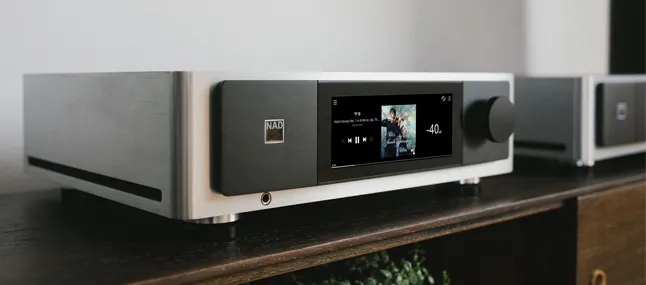
Craig Joyce is seriously impressed by this super-sophisticated, feature-packed network preamp…
NAD Electronics
M66 Masters Streaming BluOS DAC/Preamplifier
£4,499 RRP
__large_full.jpg)
To my ears, the best-sounding room at the recent Melbourne StereoNET Hi-Fi & AV Show featured a pair of DALI Epikore 11 loudspeakers powered by NAD M23 power amplifiers. NAD's recently released M66 streaming preamplifier was driving these, which the company's Product Manager Cas Oostvogel describes as "three things in one, if you like". It's a pure audiophile preamp, a powerful digital front end and a comprehensive room correction system in a single chassis.
As the 'M' suggests, it's a Masters Series product – which is NAD Electronics' flagship range of high-end audio products, encompassing various components like integrated amplifiers, preamplifiers, power amplifiers and network audio players. The M66, while a new product, is an evolution of previous designs, building on the innovations and successes of its predecessors. The C658 was the first NAD to include Dirac and have a fully integrated deployment of BluOS on board. The M12 was one of the first stereo products in the Masters Series to support NAD's proprietary Modular Design Construction (MDC) expansion module capability. The M66 takes all this a step further with Dirac Live Bass Control and four independent subwoofer outputs, plus support for two of the latest MDC2 modules.
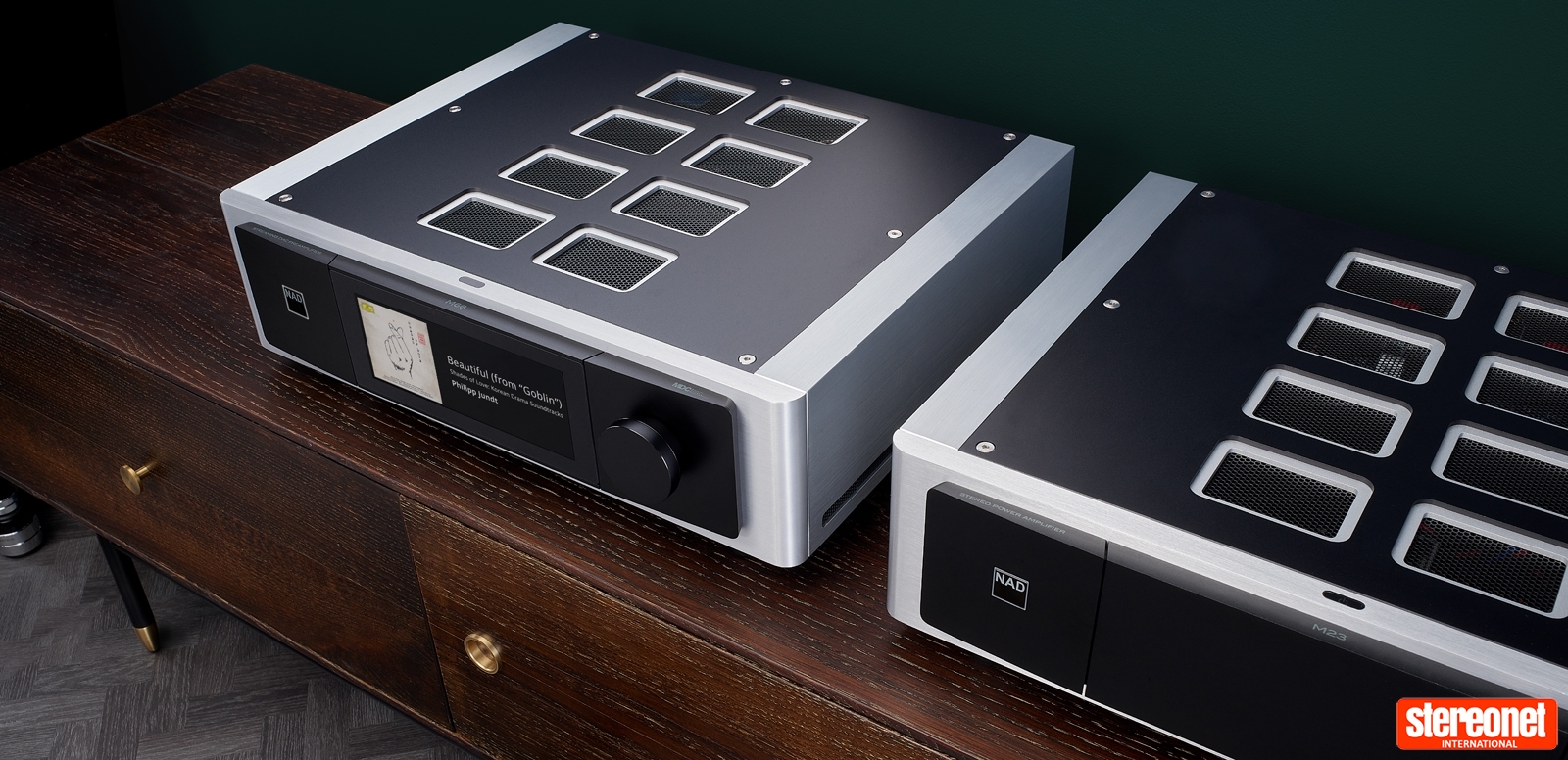
UP CLOSE
While the current Masters Series chassis was introduced some time ago, it remains an appealing design. Sitting in a typical 2RU form factor (435x133x396mm, WxHxD) and weighing 9.7 kg, the aluminium chassis is both minimal and striking. Should you elect to pair the M66 with other Masters series components, the look is arresting. Within the chassis, the various sections of the unit (analogue, digital audio, power supplies) are all shielded from each other by way of metal covers and sections under the chassis hood. The feet are spiked and come with accompanying coasters to protect the cabinetry from unexpected scratches.
The front panel is adorned with a lovely, easy-to-use 7" colour touchscreen display that allows for device configuration, switching of inputs and displaying cover art. A quality infrared remote control is included, and alternative modes of control are available through various streaming apps and desktop applications. To get to grips with the configuration of the M66, the easiest approach is the relatively unadorned NAD-branded web interface.
The NAD has a comprehensive array of input options, including two optical and two coaxial S/PDIF inputs, one AES/EBU balanced digital input, as well as two pairs of RCA line analogue inputs and one pair of XLR balanced inputs. There's also an HDMI port with eARC support for enhanced audio return capabilities to play ball in a multimedia setup. I'd find it hard to need more inputs than those available, but for those that need it, here's where NAD's Modular Design Construction technology comes in…
__large_full.jpg)
MDC lets you expand the M66's capabilities, helping to ensure product longevity and up-to-date functionality. It is present in two form factors, MDC and MDC2, with this product offering two MDC2 expansion slots. The modules available include options for digital and analogue audio enhancement, Dolby Atmos, HDMI connectivity, and 4K video support. This kind of modular flexibility is a welcome addition to a preamplifier, and something I've only also come across with the high-end Linn Selekt DSM Edition Hub.
The M66 is equipped with a wide range of audio outputs to ensure versatile connectivity to downstream power amplifiers. It features both unbalanced RCA and balanced XLR outputs and, in what appears to be a unique configuration for a two-channel device, there are four unbalanced RCA and four balanced XLR subwoofer outputs. Their presence is clearly designed to maximise the included Dirac Live licensing.
In a less typical fashion for a high-end preamp, the M66 includes a headphone output on the front of the unit, directly under the touchscreen. NAD's Cas Oostvogel explains: "This particular design is a refinement of a design by Bjorn Erik Edvardsen (the BEE in some older NAD model numbers). It's pretty much like a mini power amp and will drive 16 ohm phones with ease, delivering up to 5V output, and 600 ohms provides 150mW output".
Satisfyingly, a phono stage has been included in the M66. This is also a BEE design providing separate moving magnet and moving coil inputs with a signal-to-noise ratio that the manufacturer claims is well into 80dB territory for both inputs. Gain settings are provided to accommodate different output levels for cartridges, and as usual with other NAD phono stages, an infrasonic filter is incorporated into the design.
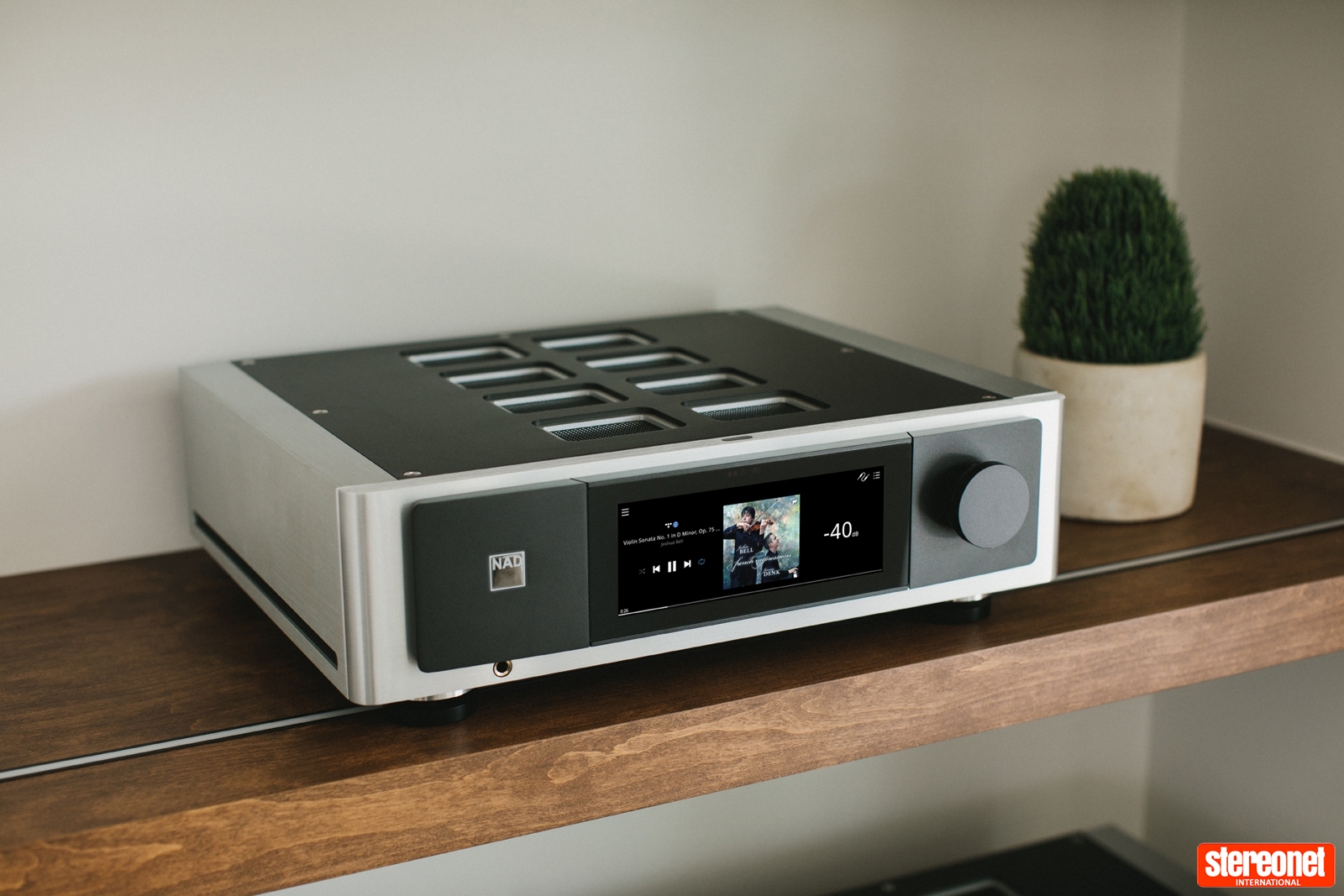
The M66's designers elected to go for the ESS Sabre ES9038PRO digital converter chip for left and right channels, "which not only measures extremely well but also sounds very good". Separate precision clocks are used for 44.1 kHz and 48 kHz (and corresponding multiples), alongside a carefully designed power supply and clean printed circuit board layout. The aforementioned four independent subwoofer outputs each get the well-respected Texas Instruments PCM5122 DAC.
The M66 boasts flexible signal path options, accommodating an all-analogue chain, a full DSP pathway, or a hybrid approach. Should digital processing be chosen, it converts analogue signals using its ES9842 ADC, processes them at a 24/192 rate for features like Dirac or Dynamic Digital Headroom, and then directs them to the DAC. For a pure analogue path, Cat Oostvogel says that "the analogue input signals are channelled by high-quality relays to a small buffer amp (TI OPA1656 op-amp). From here, it travels in balanced mode to a resistor ladder-based volume control. The still-balanced signal then goes into an OPA1656 again as a buffer to the XLR balanced output sockets." NAD also notes that the analogue and digital section possess their own separate power supplies.
A gigabit Ethernet connection or Wi-Fi provides network connectivity to the M66. The configuration of these settings can readily be made on the touchscreen or more easily via the web interface. Bluetooth connectivity is offered, with support for both AAC and LDAC, plus the recently released aptX HD high-definition codec. To avoid any RF contamination in the system, the Wi-Fi and Bluetooth transceivers inside can be switched off completely.
Streaming duties on the M66 are handled through the onboard BluOS network streamer. Via the recently updated (and more intuitive) BluOS v4 app, accessible on either a smart device or personal computer, listeners have the convenience of playing music from their favourite streaming services, their own music libraries, and numerous internet radio stations, at up to 24/192 resolution. Native connectivity to a vast range of streaming services is offered, and the device also supports Apple AirPlay 2, Spotify Connect and Tidal Connect. As with every BluOS-enabled component, the M66 is fully equipped with MQA decoding and rendering capacity. While promoted as a Roon Ready device, at the time of this review, the M66 is still listed as uncertified by Roon. NAD expects this to be cleared in the coming weeks.
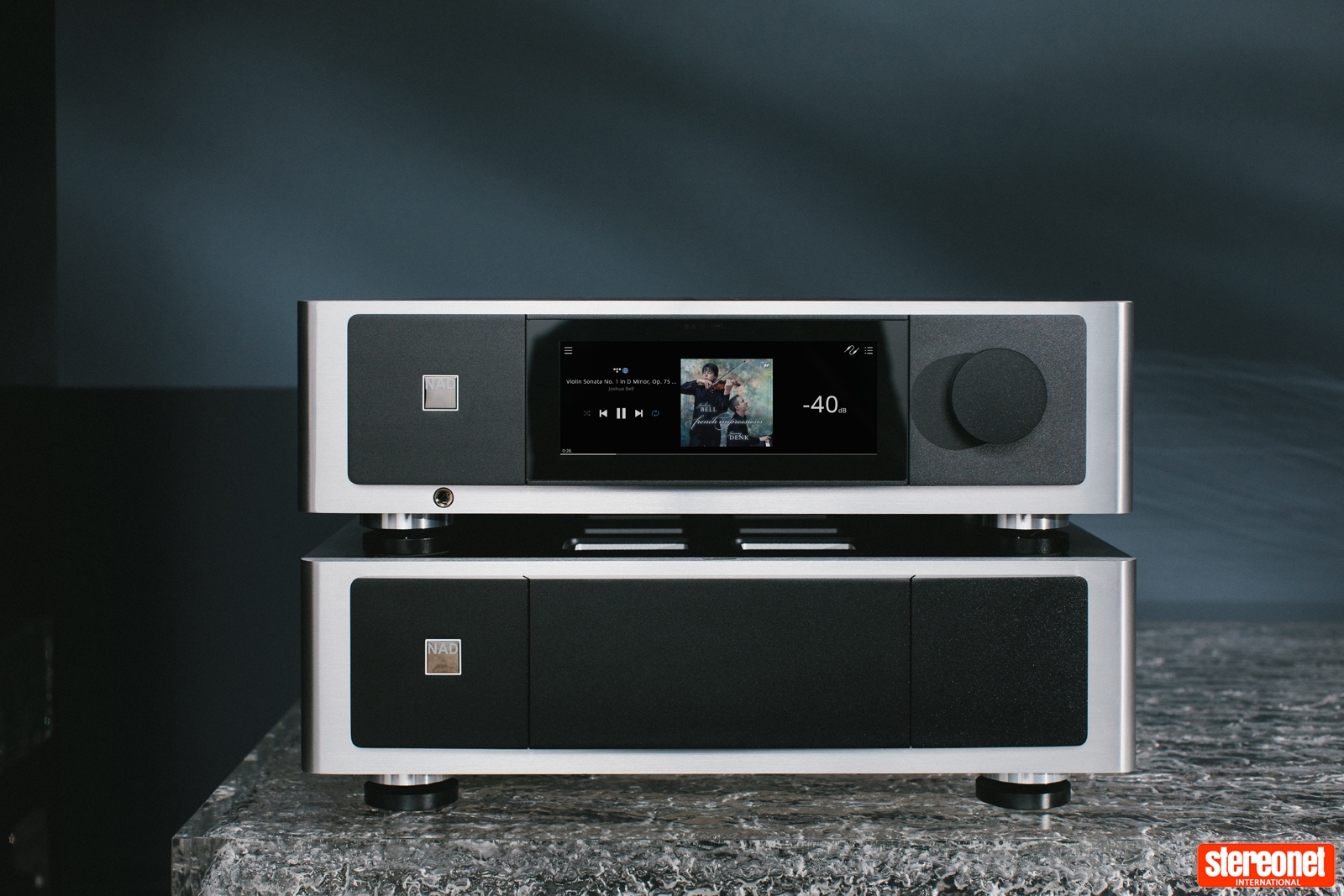
Marking a new development in stereo components, the M66 offers both balanced and single-ended subwoofer outputs, utilising Dirac Live Bass Control. Simply connect a suitable microphone to its USB port, use the Dirac Live app for setup, and you can create filters to enhance sound quality, targeting issues like standing waves and reflections. Past experiences with this software on the Arcam AV41 resulted in richer bass, better tonal accuracy, a clearer sound and sharper imaging.
The M66 is also set to receive an exciting update, as NAD has confirmed plans to introduce support for Dirac Live Active Room Treatment (ART) through an upcoming upgrade available for customer purchase. ART is an advanced audio calibration technology that optimises the acoustics of a room using the existing speaker setup. It calibrates speakers as a unified system, actively reducing room decay time, cancelling out lingering bass, and eliminating bass smearing. Using ART on my Storm Audio ISP Core 16 processor has greatly enhanced my listening experience. Bass response is now more uniform, and the sweet spot for listening has significantly expanded throughout the room.
The M66 is designed to seamlessly integrate with various home systems such as Control4, Crestron, ELAN, RTI, and URC, among others. Additionally, it provides the convenience of voice-controlled playback through compatibility with Amazon Alexa and Apple Siri.
To evaluate the M66's performance in my system, I streamed hi-res audio using the BluOS app from Qobuz. The NAD acted as a preamplifier for a pair of McIntosh MC1201 monoblocks with a pair of JBL K2 S9900 main loudspeakers and Paradigm Signature Sub1 and Ascendo 16.5" active subwoofers. Prior to listening, I created a pair of Dirac Live filters, one including the Bass Control module for comparison purposes.
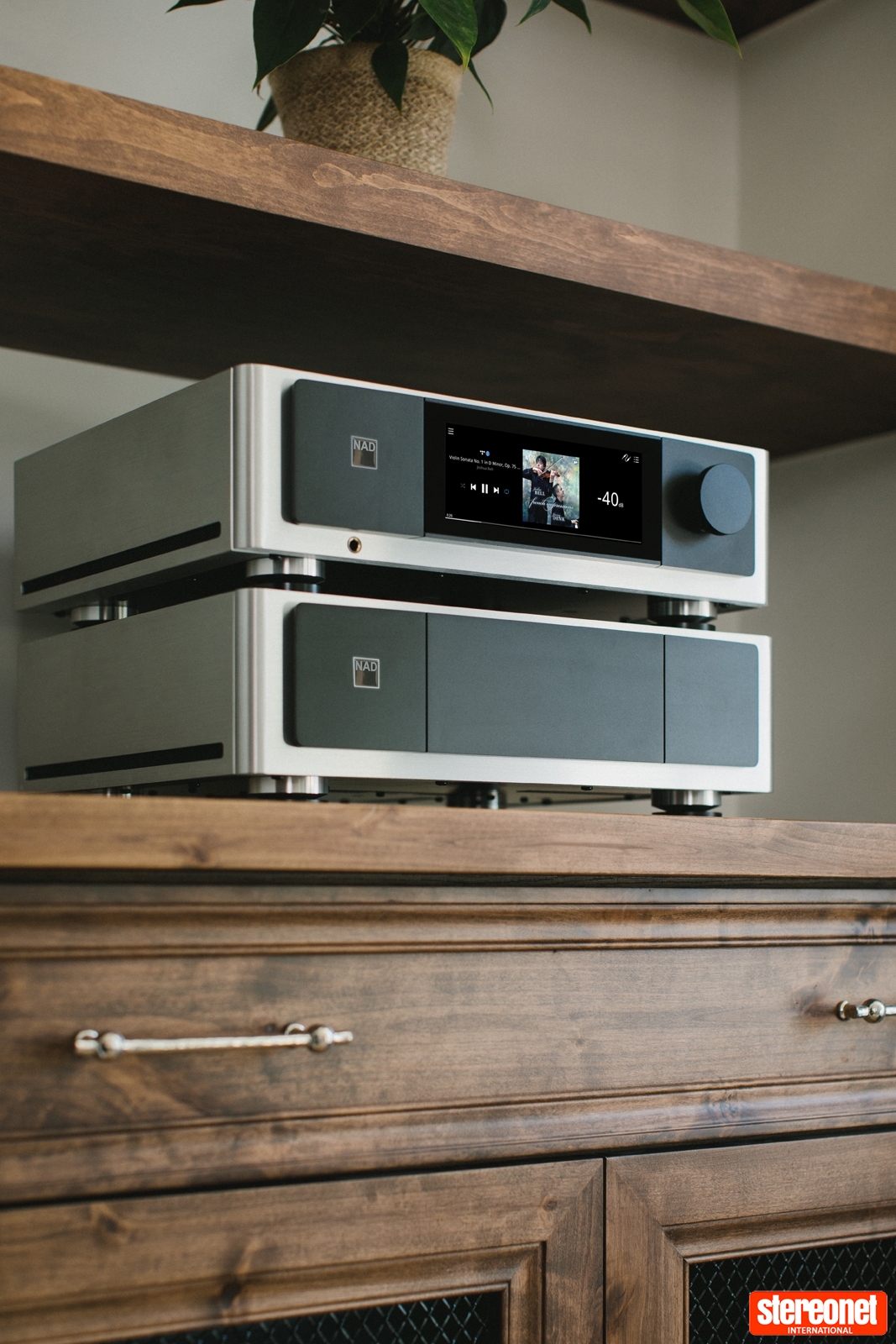
THE LISTENING
This preamplifier is a sophisticated and versatile audio component that enhances the listening experience across a wide range of musical genres. Its advanced features, such as Dirac Live Bass Control and independent subwoofer outputs, help to deliver an exceptionally precise and immersive soundstage. The M66's ability to present music with absolute accuracy and laser-like focus makes it a standout choice for audiophiles seeking to delve deeper into their music collections. Whether it's bringing clarity to the complex layers of electronic music, enhancing the depth of rock vocals, or revealing the subtle nuances in percussive elements, the NAD delivers a rich, detailed, and balanced audio experience.
The Trent Reznor remix of Peter Gabriel's Growing Up shows how a fresh rendition can invigorate a previously understated track. Reznor's clever incorporation of industrial percussion and synthesisers injects great energy into the song. In this context, the M66 shines, offering a broad soundstage and unparalleled precision in imaging. Its stereo listening field is characterised by exceptional focus, and the integration of Dirac Live Bass Control filters extends this precision to bass content. The bottom end is fluid and engaging but not bloated, and kicks, rumbles and pops without ever sounding overblown.
NAD's implementation of Dirac Live software is a game changer. The inclusion of four independent subwoofer outputs lets you milk the best you can from the Dirac modules and nail down the optimal configuration in your home; with it dialled in correctly, I don't think there's a better value addition you can make to a hi-fi system.
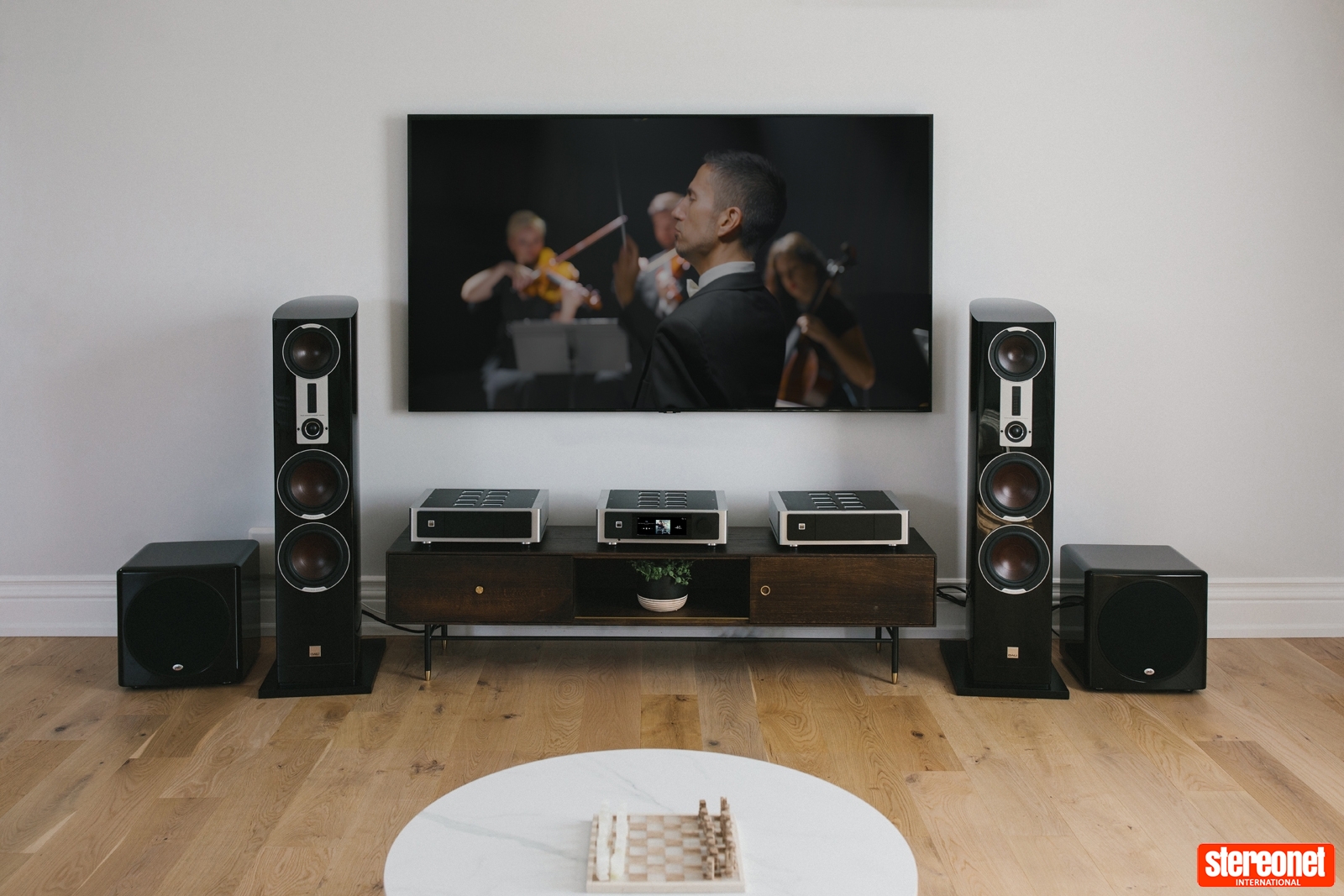
Scram from the Plump DJs is a techno-infused track that's constantly building and breaking. Through the M66, the mix is extremely aggressive, and the clever use of dynamic compression lets things breathe amongst the chaos. The synth bass line sits central to the mix, with sampled breaks and percussion threatening to tear your head off at high volume levels. The M66 proves well able to reproduce this in all its glory.
With more traditional rock fare, Thom Yorke's ethereal vocals on Radiohead's Lucky blend seamlessly with the guitars to create a dreamlike vista. This preamplifier's nuanced handling enhances the track's subtle intricacies, such as the gentle reverberation of the initial guitar strums and the complex interplay of electronic elements during the bridge. Yorke's voice, already notable for its unique qualities, is given additional depth and sharpness, making his emotive performance even more striking.
The preamplifier's transparent and faithful reproduction ensures that his vocals are not just heard but felt, adding a new dimension to the listener's engagement with the song. The dynamic shifts between the introspective verses and the more robust chorus are conveyed with remarkable precision. The NAD preamplifier deftly handles these transitions, capturing the sudden swell of intensity without losing the finer details of the quieter moments. This is an accurate and neutral-sounding design which doesn't impose any colouration on the sound.
The M66 is keen to help reinvigorate your listening patterns by introducing new insights into previously loved favourites. Streaming Natural One from the Folk Implosion opened my eyes to how well-produced it really is. The liberal use of room acoustics on the sampled drums ring out as though the kit is right in front of you in the room, and Lou Barlow's double-tracked vocals appear like an apparition in the left and right channels. The effect is to reveal that this seemingly lo-fi production is really something more exotic and otherworldly.
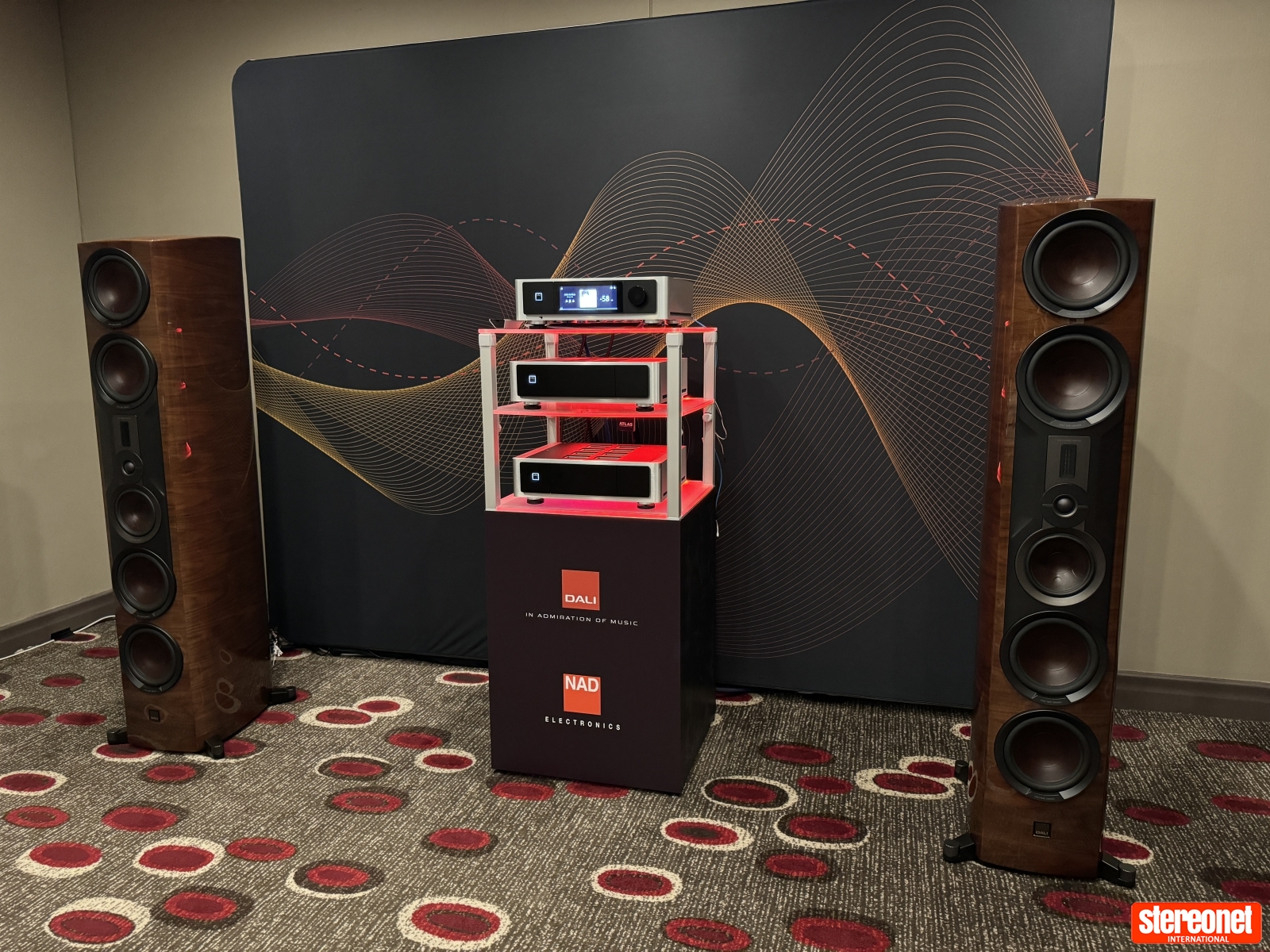
This preamp's soundstaging is superlative. Pale Sketcher's The Rainy Season lives halfway between a clattering industrial dance music piece and a bass monster. The NAD lays this dense composition open, letting the track evolve through the careful production choices of Justin Broadrick. The track's opening synthetic strings are not only pretty, but through the M66, they carry real emotional heft. The looped sampled percussion is tight and well-rendered, and the ghost notes of the breaks are unprocessed and sit in the pocket. The treated vocals shimmer in their tremolo effect, and the careful application of reverb provides a clear vantage point to decisions made during the track's production.
Yet what brings me back to The Rainy Season time and again isn't percussion or synths but rather the epic scale of the track. A huge bass line anchors this track to terra firma, heading well down into the bottom end of anybody's spectrum analyser. With the standard Dirac Live filters applied, the playback on this bassline is agreeable but not outstanding. Switch to a filter created with Dirac Live Bass Control, and the change is enveloping – bass seems to fill the room, with variations between my listening positions far less pronounced. In my twin subwoofer setup, Bass Control delivers a fantastic result. Dirac's Active Room Treatment, albeit a future paid-for upgrade, will likely take that to the next level if my past experiences with this software module translate across to the M66.
This NAD preamplifier is a refined and adaptable audio device, perfect for the eclectic music enthusiast. It combines cutting-edge technology with extensive connectivity, offering a soundstage that's incredibly precise and captivating. Its standout quality lies in its exceptionally accurate imaging, which has pinpoint focus. The inclusion of an onboard implementation of the BluOS streaming platform is a practical design choice that opens listeners up to a plethora of source material (including local network file share streaming) and will help you re-experience your music collection in a flexible manner.
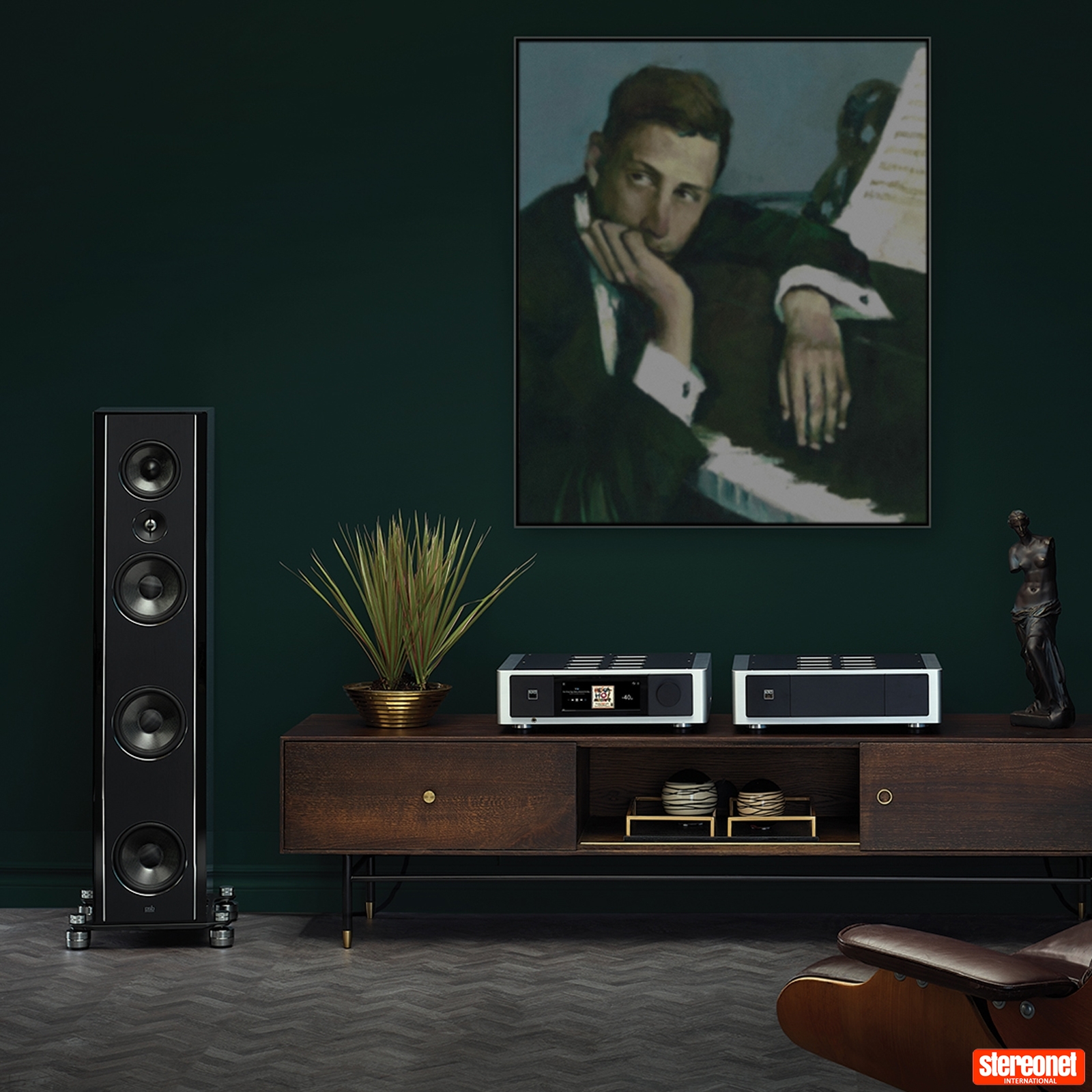
THE VERDICT
 Taking the form factor of a traditional stereo preamplifier and supercharging the connectivity to previously unseen heights, NAD's new M66 is more than just a component – it's a gateway to rediscovering music, presenting it in a way that is true to the original recording. Sitting at a price point that is still approachable for many is a serious achievement. Additionally, the modularity and software-centric approach to new functionality is to be applauded and rewarded in a world of built-in obsolescence. NAD's evolutionary journey in audio engineering has reached a significant milestone with the M66, and I expect the device to be a prominent fixture in many discerning audio systems moving forward.
Taking the form factor of a traditional stereo preamplifier and supercharging the connectivity to previously unseen heights, NAD's new M66 is more than just a component – it's a gateway to rediscovering music, presenting it in a way that is true to the original recording. Sitting at a price point that is still approachable for many is a serious achievement. Additionally, the modularity and software-centric approach to new functionality is to be applauded and rewarded in a world of built-in obsolescence. NAD's evolutionary journey in audio engineering has reached a significant milestone with the M66, and I expect the device to be a prominent fixture in many discerning audio systems moving forward.
For more information visit NAD Electronics
Craig Joyce
With an engineering degree in digital signal processing and a storied career in IT networking and cyber security, Craig loves to push the boundaries of audio technologies. An aficionado of live music with personal detours in music production and event promotion, Craig is a long time enthusiast of post punk, electronic and experimental music.
Posted in: Amplifiers | Preamplifiers | Applause Awards | 2023 | DACs | Loudspeakers | Floorstanding | Sources | Streamers | Hi-Fi
JOIN IN THE DISCUSSION
Want to share your opinion or get advice from other enthusiasts? Then head into the Message
Forums where thousands of other enthusiasts are communicating on a daily basis.
CLICK HERE FOR FREE MEMBERSHIP
Trending
applause awards
Each time StereoNET reviews a product, it is considered for an Applause Award. Winning one marks it out as a design of great quality and distinction – a special product in its class, on the grounds of either performance, value for money, or usually both.
Applause Awards are personally issued by StereoNET’s global Editor-in-Chief, David Price – who has over three decades of experience reviewing hi-fi products at the highest level – after consulting with our senior editorial team. They are not automatically given with all reviews, nor can manufacturers purchase them.
The StereoNET editorial team includes some of the world’s most experienced and respected hi-fi journalists with a vast wealth of knowledge. Some have edited popular English language hi-fi magazines, and others have been senior contributors to famous audio journals stretching back to the late 1970s. And we also employ professional IT and home theatre specialists who work at the cutting edge of today’s technology.
We believe that no other online hi-fi and home cinema resource offers such expert knowledge, so when StereoNET gives an Applause Award, it is a trustworthy hallmark of quality. Receiving such an award is the prerequisite to becoming eligible for our annual Product of the Year awards, awarded only to the finest designs in their respective categories. Buyers of hi-fi, home cinema, and headphones can be sure that a StereoNET Applause Award winner is worthy of your most serious attention.





